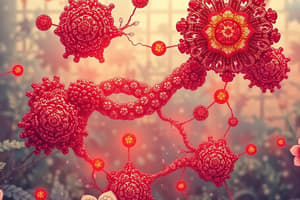Podcast
Questions and Answers
What is the fundamental role of a catalyst in a biochemical reaction?
What is the fundamental role of a catalyst in a biochemical reaction?
- To be consumed during the reaction to produce energy.
- To increase the rate of the reaction without being consumed. (correct)
- To alter the equilibrium of the reaction, favoring product formation.
- To decrease the rate of the reaction by binding to reactants.
The Greek origin of the word "enzyme" gives insight into its function. What does 'zyme' refer to?
The Greek origin of the word "enzyme" gives insight into its function. What does 'zyme' refer to?
- Yeast (correct)
- Energy
- Protein
- Reaction
A simple enzyme is composed of which of the following?
A simple enzyme is composed of which of the following?
- Apoenzyme and a cofactor
- Protein and a non-protein part
- Only protein (correct)
- A coenzyme and a substrate
What is the role of a coenzyme in enzyme function?
What is the role of a coenzyme in enzyme function?
How does the naming system for enzymes typically provide information about the enzyme?
How does the naming system for enzymes typically provide information about the enzyme?
Which suffix is commonly used to identify a substance as an enzyme?
Which suffix is commonly used to identify a substance as an enzyme?
What type of reaction does an oxidoreductase catalyze?
What type of reaction does an oxidoreductase catalyze?
Which class of enzyme catalyzes the transfer of a functional group from one molecule to another?
Which class of enzyme catalyzes the transfer of a functional group from one molecule to another?
A hydrolase is characterized by its ability to catalyze which type of reaction?
A hydrolase is characterized by its ability to catalyze which type of reaction?
Which type of enzyme catalyzes the addition of a group to a double bond or the formation of a double bond by removing a group, without hydrolysis or oxidation?
Which type of enzyme catalyzes the addition of a group to a double bond or the formation of a double bond by removing a group, without hydrolysis or oxidation?
What is the primary function of an isomerase?
What is the primary function of an isomerase?
Ligases are known for catalyzing which type of reaction?
Ligases are known for catalyzing which type of reaction?
What is the enzyme active site?
What is the enzyme active site?
According to the Lock-and-Key Model, what characterizes the interaction between an enzyme and its substrate?
According to the Lock-and-Key Model, what characterizes the interaction between an enzyme and its substrate?
How does the Induced-Fit Model differ from the Lock-and-Key Model of enzyme-substrate interaction?
How does the Induced-Fit Model differ from the Lock-and-Key Model of enzyme-substrate interaction?
What does absolute specificity in enzyme activity refer to?
What does absolute specificity in enzyme activity refer to?
What does stereochemical specificity of an enzyme imply?
What does stereochemical specificity of an enzyme imply?
How does temperature affect enzyme activity?
How does temperature affect enzyme activity?
Outside of its optimal range, how does pH affect enzyme activity?
Outside of its optimal range, how does pH affect enzyme activity?
What happens to the rate of an enzyme reaction as substrate concentration increases, assuming enzyme concentration remains constant?
What happens to the rate of an enzyme reaction as substrate concentration increases, assuming enzyme concentration remains constant?
How does an enzyme inhibitor affect enzyme-catalyzed reactions?
How does an enzyme inhibitor affect enzyme-catalyzed reactions?
In reversible competitive inhibition, how does the inhibitor affect the enzyme?
In reversible competitive inhibition, how does the inhibitor affect the enzyme?
How does a noncompetitive inhibitor affect enzyme activity?
How does a noncompetitive inhibitor affect enzyme activity?
What characterizes irreversible enzyme inhibition?
What characterizes irreversible enzyme inhibition?
What distinguishes allosteric enzymes from other enzymes?
What distinguishes allosteric enzymes from other enzymes?
Flashcards
Enzyme
Enzyme
An organic compound that acts as a catalyst for a biochemical reaction.
Catalyst
Catalyst
A substance that increases the rate of a chemical reaction without being consumed.
Simple enzyme
Simple enzyme
An enzyme composed only of protein.
Conjugated enzyme
Conjugated enzyme
Signup and view all the flashcards
Apoenzyme
Apoenzyme
Signup and view all the flashcards
Cofactor
Cofactor
Signup and view all the flashcards
Holoenzyme
Holoenzyme
Signup and view all the flashcards
Substrate
Substrate
Signup and view all the flashcards
Oxidoreductase
Oxidoreductase
Signup and view all the flashcards
Transferase
Transferase
Signup and view all the flashcards
Hydrolase
Hydrolase
Signup and view all the flashcards
Lyase
Lyase
Signup and view all the flashcards
Isomerase
Isomerase
Signup and view all the flashcards
Ligase
Ligase
Signup and view all the flashcards
Enzyme active site
Enzyme active site
Signup and view all the flashcards
Enzyme-substrate complex
Enzyme-substrate complex
Signup and view all the flashcards
Lock-and-Key Model
Lock-and-Key Model
Signup and view all the flashcards
Induced-Fit Model
Induced-Fit Model
Signup and view all the flashcards
Absolute Specificity
Absolute Specificity
Signup and view all the flashcards
Stereochemical specificity
Stereochemical specificity
Signup and view all the flashcards
Group specificity
Group specificity
Signup and view all the flashcards
Linkage specificity
Linkage specificity
Signup and view all the flashcards
Enzyme Inhibitor
Enzyme Inhibitor
Signup and view all the flashcards
Competitive enzyme inhibitor
Competitive enzyme inhibitor
Signup and view all the flashcards
Noncompetitive enzyme inhibitor
Noncompetitive enzyme inhibitor
Signup and view all the flashcards
Study Notes
- Enzymes are organic compounds acting as catalysts for biochemical reactions
- Catalysts increase reaction rates without being consumed
- Greek roots of enzyme are "en" (in) and "zyme" (yeast)
- Each human cell possesses thousands of specific enzymes for cellular reactions
- Enzymes accelerate cellular reactions up to millions of times faster
- Enzymes are not consumed
Enzyme Structure
- Enzymes have two general structure classes: simple and conjugated
- Simple enzymes consist solely of protein
- Conjugated enzymes incorporate a nonprotein part in addition to a protein
- Apoenzyme is the protein part of a conjugated enzyme
- Cofactor is the nonprotein part, which can be a small organic molecule or inorganic ion
- Metal ions such as Zn2+, Mg2+, Mn2+, and Fe2+, or nonmetal ions like Cl- can be cofactors
- Coenzyme is a small organic molecule serving as a cofactor
- A biochemically active enzyme results from the combination of an apoenzyme and cofactor
- A holoenzyme is a biochemically active conjugated enzyme
Enzyme Nomenclature and Classification
- Enzymes typically use a naming system providing functional information
- The nomenclature focuses on the reaction type and substrate identity
- The substrate is the enzyme-catalyzed reaction reactant
- The suffix "-ase" identifies a substance as an enzyme
- Some early-studied digestive enzymes still have names with the "-in" suffix
- Prefixes denote the type of reaction catalyzed
- "oxidase" indicates an oxidation reaction, while "hydrolase" indicates a hydrolysis reaction
- The substrate's identity is often added to the type of reaction, such as in glucose oxidase
Six Major Enzyme Classes
- Enzymes are classified based on the reactions they catalyze:
- Oxidoreductase catalyzes oxidation-reduction reactions.
- These require a coenzyme to be oxidized or reduced with the substrate.
- Lactate dehydrogenase removes hydrogen atoms as an oxidoreductase
- Transferase transfers functional groups between molecules
- Transaminases catalyze amino group transfers
- Kinases catalyze phosphate group transfers from ATP
- This yields ADP and a phosphorylated product
- Hydrolase catalyze hydrolysis reactions using water to break bonds
- Carbohydrases break glycosidic bonds
- Proteases break peptide linkages in proteins
- Lipases break ester linkages in triacylglycerols
- Lyase adds groups to double bonds or forms double bonds without hydrolysis or oxidation
- Dehydratase removes water components to form a double bond
- Hydratase adds water to a double bond
- Isomerase catalyzes the rearrangement of atoms within a molecule
- This converts the substrate into an isomeric form of itself
- There is only one reactant and product in isomerization
- Ligase joins two molecules into one, using ATP to participate
Models of Enzyme Action
- Enzymes act through an active site, a small portion where interaction occurs
- The active site is a 3D entity from different protein chain parts
- An enzyme-substrate complex is an intermediate formed when a substrate binds to the enzyme's active site
Lock-and-Key Model
- Lock-and-Key entails a fixed, rigid geometrical conformation at the enzyme's active site
- Only substrates with complementary geometry can be accommodated, common for numerous enzymes
Induced-Fit Model
- Induced-Fit incorporates flexibility in the enzyme's shape
- This allows small active site changes to accommodate the substrate
- Electrostatic interactions, hydrogen bonds, and hydrophobic interactions attract and bind substrate molecules
Enzyme Specificity
- Absolute Specificity: an enzyme acts on only one substrate, uncommon
- For example, Urease
- Stereochemical specificity involves distinguishing between stereoisomers
- L-amino-acid oxidase acts on L-amino acids but not D-amino acids
- Group specificity involves similar compounds with the same functional groups
- For example, Carboxypeptidase cleaves amino acids from the carboxyl end of the peptide chain
- Linkage specificity acts on a particular bond type
- Regardless of the structural features, phosphatases hydrolyze phosphate-ester bonds
Factors Affecting Enzyme Activity
- Temperature: reaction rate increases with temperature, but denatures past a certain point
- pH: enzymes have a narrow optimal pH range or denaturation occurs
- Substrate Concentration: reaction rate increases until full saturation, then levels off
- Enzyme Concentration: reaction rate increases with concentration, assuming substrate is more abundant
Enzyme Inhibition
- Inhibitors reduce rates of enzyme-catalyzed reactions
- Enzyme inhibitors slow or stop enzyme catalytic function by binding to it
- There are three modes of inhibition:
- Reversible competitive, reversible noncompetitive, and irreversible
Reversible Competitive Inhibition
- It involves inhibitors resembling the substrate, competing for the enzyme's active site
- Binding is temporary, preventing substrate occupancy and blocking the reaction
- Weak interactions maintain the complex, which breaks, freeing the active site over time
- Substrate and inhibitor compete
Reversible Noncompetitive Inhibition
- The inhibitor binds to a site other than the active site, decreasing enzyme activity
- The substrate still occupies the active site, but an enzyme structure change prevents proper catalysis
Irreversible Inhibition
- It involves inhibitors forming strong covalent bonds to active site amino acid side-chains, inactivating the enzyme
- These inhibitors often do not have structures similar to the enzyme's normal substrate
Allosteric Enzymes
- These enzymes have multiple protein chains (quaternary structure) and two binding sites: substrate and regulator
- Regulators, substances binding at the regulatory sites, are either positive or negative
- Positive regulators increase enzyme activity, and negative regulators decrease it
Regulation of Enzyme Activity
- Feedback Control involves product-controlled activation/inhibition of the first reaction in a sequence
- Proteolytic Enzymes and Zymogens: inactive precursors require an enzyme-controlled reaction to remove parts of their structure
- The proteolytic enzyme is the active form of a zymogen Covalent Modification of Enzymes happens through the attachment/removal of a chemical group to/from particular amino acids
Studying That Suits You
Use AI to generate personalized quizzes and flashcards to suit your learning preferences.




